The foreword to the standard states, among other things, that it includes not only the statutory units but also corresponding sizes stated in Anglo-American units. Under the German Units of Measurement Act, 22nd February 1985, the use of such units nationally and commercially in Germany is proscribed. Such units may only be quoted to aid business relationships with countries which still use these units.
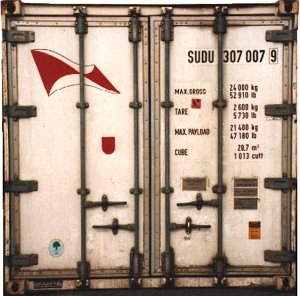 |
Marking on the door of a container |
A distinction is drawn between compulsory and optional marking. Compulsory ISO marking must be used on all containers, while optional marking does not have to be: they are included in the standard to improve understanding and to promote uniform application of marking. However, if a particular style of representation is specified for an optional mark, it must be complied with. The terms "compulsory" and "optional" used in the standard do not apply to the requirements of any legislative bodies, however.
The following is a basic version of horizontal container marking.
 |
Container identification marking |
| This Figure shows a version of vertical container marking. | 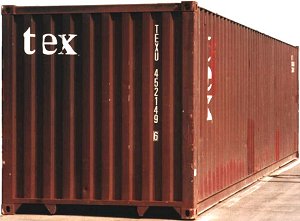 |
| Marking on the front end of a container |
The container identification system specified in DIN EN ISO 6346 consists solely of the elements shown, which can only be used together:
- owner code, consisting of three capital letters
- product group code, consisting of one of capital letters U, J or Z
- six-digit registration number
- check digit
The product group code consists of one of the following three capital letters:
| U | - | for all freight containers |
| J | - | for detachable freight container-related equipment |
| Z | - | for trailers and chassis |
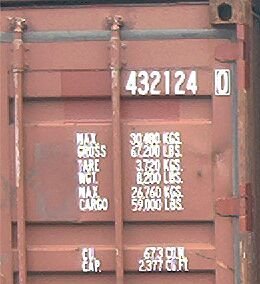 |
Alpha prefix absent |
If the owner code is absent, the container cannot be identified.
The registration or serial number consists of six digits. In the examples shown, these numbers are 307007 and 452149. If the container number consists of fewer than six digits, it is preceded by enough zeros to make a six-digit number sequence.
The check digit, 9 and 6 respectively in the two examples shown, is always a single-digit number. It is usually in a box, to make it stand out from the registration number.
The check digit can be used to validate whether the owner code, product group code and registration number have been accurately transmitted. No freight information system (FIS), transport information system (TIS) or similar data processing system will accept a container number, if the result of the automatic checking procedure does not show agreement with the check digit. The procedure is deliberately designed to ensure that a number of transmission errors cannot cancel one another out, resulting in the acceptance of incorrect data. The checking procedure is as follows:
An equivalent numerical value is assigned to each letter of the alphabet, beginning with 10 for the letter A (11 and multiples thereof are omitted):
 |
The individual digits of the registration number keep their everyday value, i.e. 1 = 1, 2 = 2 etc.
The following numerical values are accordingly obtained for the two examples with the alpha prefixes "SUDU" and "TEXU":
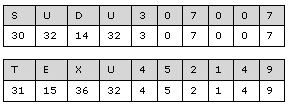 |
Each of these numbers is multiplied computationally, as a function of its position, by numerical values of 20 to 29: the first number by 1, the second by 2, the third by 3 and the 10th by 512.
 |
The following calculations are performed for the two examples:
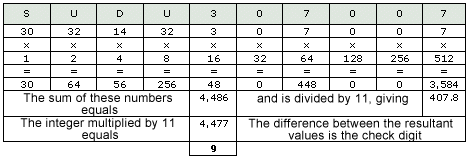 |
 |
If the check digits 9 and 6 respectively are correctly input in each case during data entry, the system accepts the data.
If someone makes a mistake when transmitting a container number and inputs the alphanumeric sequence TEXU 452149 into a corresponding system instead of TEXU 452159, the program would perform the following calculation:
 |
Since the correct check digit for this container is 6, the system would indicate an error.
 |
|
| Disadvantage of check digit |
The check digit 0 may occur twice, since it arises where the final difference is 0 and where it is 10. To ensure that this does not happen, the standard recommends that registration numbers should not be used which produce a final difference of 10. This is the case, however, with the registration number shown.
 |
 |
|
| Correct identification using check digit |
 |